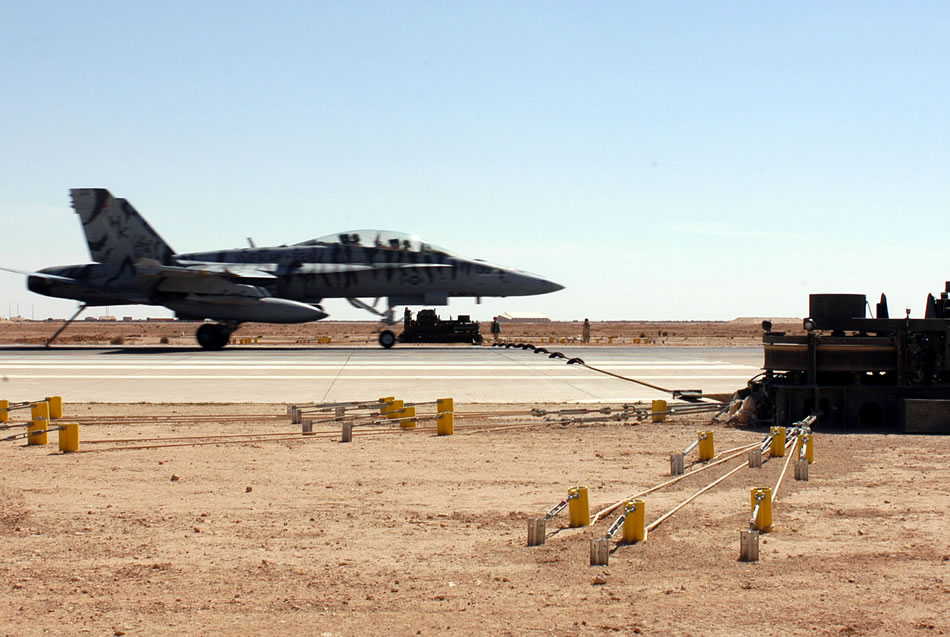
Posted: 03/01/2005
Discussion Board on this Photo
Story by Cpl. Rocco DeFilippis, Photos by Lance Cpl. Andrew Pendracki
AL ASAD, Iraq (March 26, 2005) -- Just overthe horizon, the pilot can see the welcoming blue lights of the runway.He is trying to stay calm as he guides his disabled jet toward thelights and the safety of the ground.
Drowning out the drones of the safety system that is constantlyreminding him he has complete hydraulic failure, he focuses on theyellow light where he knows the cable is going catch his woundedaircraft and bring him to a safe stop.
Although a frightening scenario, the expeditionary airfield techniciansof Marine Wing Support Squadron 271, work daily to ensure every aspxectof the airfield, from arresting equipment to runway lighting, isoperational to support the aircrews here.
"We do anything and everything on the airfield," said Lance Cpl. CalebJ. Fox, expeditionary airfield technician and native of Rio Linda,Calif. "Everything from the lighting and markings, to maintaining therecovery equipment and repairing the surface of the runway. We haveeven chased wild dogs off the runway and out of the path of jets takingoff."
Although the runways and taxi strips are now suitable for most types ofaircraft in the military, expeditionary airfield Marines from differentsquadrons have worked extremely hard to take the dilapidated airfieldto where it is today.
Lance Cpl. Barrett A. Crow, who is on his second deployment supportingOperation Iraqi Freedom, said the airfield has come a long way sincehis time here last year.
"At that time, there was only one section of the runway that wasusable," said the expeditionary airfield technician and native ofMesquite, Texas. "Since that time we have repaired numerous holes andcracks, set up permanent lighting and remarked most of the runways andtaxi strips."
One of the most critical roles the Marines play in supporting theairfield is maintaining and operating the expeditionary arresting gear,a machine that acts as a catching device for drop-hook aircraft. Like ajet landing on an aircraft carrier, the gear allows aircraft to land onexpeditionary airfields in emergency and poor weather situations.
"When you have a human life depending on that gear to stop their jet,you do everything you can to ensure it is going to work," Crow said."We check and maintain our systems every day."
In addition to the arresting gear, the Marines contribute by sprayingdust abating materials to prevent "brown-out" conditions from airbornedust and debris caused by aircraft landing and taking off.
"The dust-abatement treatments greatly improve the visibility andsafety for pilots," said Cpl. Brian D. Van Gilder, expeditionaryairfield technician and native of Adamstown, Md. "Since we've beenhere, we have sprayed thousands of gallons to ensure that the pilotscan see and have safe conditions to land in."
With all they do for the airfield in support of the 2nd Marine AircraftWing (Forward), the expeditionary airfield Marines are vital to thesuccess of the mission.
"I'm proud to be out here, this is what we have trained to do," VanGilder said. "What we do is necessary to the success of the missionhere, and it's great to be doing my part."
More Photos
1 |
2 |
3